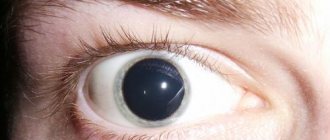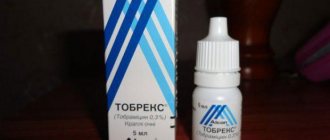Special means are used as preparation for diagnostic and therapeutic procedures and ophthalmological operations. Their main purpose is to dilate the patient’s pupils as much as possible and cause temporary blocking of the receptors responsible for their narrowing. This results in a reduction in intraocular pressure and the ability to carry out examinations and therapy. Midrimax eye drops are a drug that is prescribed to adults before medical procedures necessary to treat the eyes.
What does the drug consist of and how does it work?
The active components of the drug are phenylephrine hydrochloride (50 milligrams per milliliter of solution) and tropicamide (8 milligrams). As excipients, the medicine includes purified water, hydrochloric acid, hypromellose, benzalkonium chloride and some sodium compounds - metabisulfide, hydroxide, disodium edetate.
Eye drops block the action of m-cholinergic receptors. They are located in the iris of the eye and in a special ciliary muscle. The effect of instillation is mydriasis - dilation of the pupil and temporary paralysis of accommodation, that is, impairment of the ability to clearly see nearby objects. After a few hours, the organs of vision return to normal.
Receptor spasm begins to develop 5 minutes after application. It is optimal to start diagnosis or treatment after half an hour - during this period the pupil dilation will reach its maximum. The effect of Midrimax will begin to decline after 1.5-2 hours. By this time, the active substances will no longer block the receptors that are responsible for normal pupil width.
From the tissues of the eye, where Midrimax is directly instilled, it enters the blood. Therefore, some effects of the drug may appear in the body as a whole. The constituent agents and their derivatives are excreted by the kidneys along with urine.
Indications for use
Indian manufacturers guarantee the environmental purity of the drug. Contains 1 ml. drops phenylephedrine (50 mg) + tropicamide (8 mg) + auxiliary ingredients that promote better absorption of drops.
Unlike Atropine, which has been used for decades to dilate the pupil and temporarily paralyze the muscle tissue of the eyes, the solutions do not contain a toxic alkaloid harmful to the body.
The instructions for the Midrimax product on the appropriateness of use read as follows:
- Recommended use before diagnosing eye diseases.
- It is used before laser vision correction and eye microsurgery.
- Allowed for the treatment (and prevention) of myopathy and astigmatism.
- It is used in combination with other drugs for diseases with increased intraocular pressure.
- Prescribed before selecting lenses or glasses.
Do not be surprised if the doctor prescribes Midrimax in cases not covered by the written instructions. Ophthalmologists in our country have extensive practice in successfully treating various diseases with mydriatics (drugs that relax accommodation).
Methods of application
The medicine is available only by prescription, since self-medication is unacceptable. The dosage of the drug and the treatment regimen are determined only by the doctor, and individually. Therefore, we will not list how many drops to drip here. As much as they say, that's what is needed.
It is important to know how installations are carried out correctly:
- You need to slightly pull the lower eyelid by the skin and drip the solution inside the conjunctival sac without touching the mucous membranes with the pipette.
- Immediately close your eye, press the corner near your nose with your finger, you cannot blink. After a minute and a half, release your eye and you can blink.
- If we wait on the couch for time before the diagnosis, it is better to sit for half an hour with your eyes closed.
- When treating the organs of vision, installations are done in the evenings, and they immediately go to bed.
In other cases, detailed instructions on how to use will be given by the doctor.
Contraindications
Any ophthalmic drug is prohibited for use due to individual intolerance. If the use of Midrimax is accompanied by allergy symptoms: swelling, itching of the eyelids, hyperemia, the drug should be discontinued.
Other contraindications:
- Glaucoma.
- Diabetes.
- Diseases of the heart and blood vessels.
- Thyrotoxicosis.
Prescribe with caution during pregnancy, childhood and old age.
Side effects
The instructions list many negative phenomena that may occur during treatment with the drug. For the most part, they occur due to an overdose or individual intolerance. You should immediately tell your doctor if the following symptoms occur:
- Pain, unbearable burning in the eyes, redness, swelling of blood vessels, photophobia.
- Change in iris color, keratitis, tearing.
- Increased or decreased blood pressure, headache.
- Skin dermatitis.
- Dizziness, convulsions.
- Strengthening or increasing heart rate.
- Vomiting, diarrhea.
An overdose can lead to nervous overexcitation, arrhythmia, and difficulty in orienting oneself.
Special conditions
The medicine should be stored on shelves inaccessible to children, cats who can throw the bottle onto the floor, as well as elderly people with insanity and alcoholics. The solution taken orally leads to coma.
In addition, it is important to know:
- If you constantly use contact lenses, it is better to remove them for the entire period of treatment with Midrimax.
- Do not use drops before work related to operating machinery in production, vehicles, airplanes, ships, trains.
- The simultaneous use of Midrimax with some antidepressants, adrenergic and anticholinergic blockers is prohibited (risk of heart attack from a hypertensive crisis).
- Combining drops with anesthetics reduces the effectiveness of the drug.
- Combined use with antihistamines greatly enhances the effect of Midrimax.
The optimal storage temperature is from 12 to 20 degrees. The permissible shelf life when sealed is one year, and after opening the bottle - 1 month.
Analogs
If it is impossible to use Midrimax due to intolerance or exclusion for a number of diseases, ophthalmologists prescribe drugs with a similar effect:
- Atropine.
- Tropicamide.
- Cyclomed.
- Midroom.
- Mydriacyl.
The difference is that each type of drop contains one of the medicinal substances contained in a complex in Midrimax, therefore all analogues are less effective.
The cost of the drops is quite high for ordinary consumers: more than 500 rubles. per bottle of 5 ml. But when assessing natural assistance, on the scales of life: a unique chance to improve the vision of the enchanting beauty of the world and a tiny piece of treasury paper, with which it is no longer possible to buy a piece of natural sausage. Of course, it is better to choose eye drops; the sausage is not made from real meat anyway. Take care of your loved ones.
Friends, we are waiting for questions, comments, reviews!
Who are the drops for?
The drug is used only in ophthalmic practice. Doctors prescribe it in the following cases:
- if you need to conduct an examination, for example, of the fundus;
- if necessary, undergo surgery, for example, laser vision correction;
- as a treatment for astigmatism, progressive myopia, dry eye syndrome and high intraocular pressure.
Midrimax is used only under the supervision of a specialist and for its specific purpose.
Basic information about the mechanism of action and features of the drops is available in the instructions for use. The ophthalmologist will focus on them when determining the dosage for a particular patient.
Drops allow you to examine the fundus of the eye.
Nuances of use
According to the instructions for the drug, it contains preservatives, the effects of which can lead to redness of the eyes, especially in patients who wear contact lenses. Due to the fact that preservatives are instantly absorbed into the structure of soft contact lenses, the latter must be removed before use. You can put them back on only after 15 minutes.
Due to the fact that when using the product, the frequency of dilator contractions increases, as a result, small particles of pigment from the layer of the iris are found in the chambers of the eye.
Pigmented chamber moisture should be distinguished from that containing blood or other inclusions. This is also stated in the instructions for use.
Reviews
Finding reviews about these eye drops is quite difficult.
This is due to the fact that their use is only before surgery and during diagnosis during treatment. From rare reviews, we can conclude that this medication is an effective ophthalmic agent that can effectively and quickly relax the muscles of the eye.
Experts say that the drug can be used not only during surgical treatment, but also for other conditions, for example, doctors often recommend using Midrimax eye drops for those patients diagnosed with dry eye syndrome. But for this disease, the drug is used in much smaller dosages.
Review from an ophthalmologist about vasoconstrictor eye drops
Manufacturer, release form, cost of the medicine
The manufacturers of the drug are Indian companies Promed Exports and Sentess Pharma.
Midrimax drops are produced in a convenient 5 ml plastic bottle with a dispenser that allows you to measure the exact amount when instilling into the eyes. The drug is an odorless and colorless liquid, sometimes with a slight yellowish tint.
Shelf life - 3 years, after opening - 21 days. Storage is carried out at above-zero temperatures and away from direct sunlight in places where the bottle cannot be reached by children.
In Russian pharmacies you can buy the product for an average of 465 rubles. The price varies depending on the region and manufacturer.
How to use Midrimax
Depending on the nature of the disease or the research method, different amounts of medicine are prescribed.
- During diagnosis and before operations, the drug is dripped into the conjunctival sac in the amount of 1-2 drops. Immediately after instillation, press with clean fingers on the inner corner of the eye and hold for about a minute. This prevents the medicine from getting from the conjunctival cavity into the nasal cavity.
- Before performing skiascopy. To successfully diagnose the ability of the pupil to refract light, the drug is administered up to 6 times at intervals of 10 minutes. The effect of paralysis of accommodation is achieved.
- For medicinal purposes. To relieve spasm of accommodation, Midrimax is dripped into each eye at night, 1-2 drops. The duration of the course is determined by the doctor.
Dilated pupils - the effect of using Midrimax.
Is Midrimax prescribed in childhood?
The instructions warn against giving Midrimax to children under adulthood. Despite this, many ophthalmologists prescribe the drug to children as therapy or during diagnosis. The indication for use is primarily the initial stage of myopia.
Treatment with Midrimax in childhood follows the same scheme as in adults.
Who should not use the drug
Midrimax has a number of contraindications. Drops should not be used in the following cases:
- in case of individual intolerance to the components of the drug;
- for diabetes mellitus;
- if a person has thyrotoxicosis;
- in the presence of glaucoma;
- in case of serious cardiovascular disorders;
- women while carrying and breastfeeding a child.
It is not recommended to combine the use of Midrimax with wearing contact lenses. Do not wear them while treatment is ongoing. Avoid driving vehicles for 4-5 hours after using the drops.
An overdose causes problems with orientation in space, irritation of the mucous membranes, and general nervous excitement.
What side effects are observed?
Eye drops can affect both the organs of vision and the body as a whole. Therefore, side effects are divided into local and systemic.
Local reactions:
- painful sensations;
- burning;
- lacrimation;
- blurred vision;
- keratitis (explain in parentheses);
- photophobia;
- allergic reactions.
Systemic manifestations (may occur in case of overdose):
- muscle rigidity (increased tone, tension);
- dysfunction of the nervous system;
- paleness of the skin;
- disorders of the heart and blood vessels (bradycardia, tachycardia), risk of heart attack in older people;
- urge to urinate.
Accidental ingestion of the drug into the gastrointestinal tract can lead to convulsions, and in severe cases, to coma.
In such a situation, you need to call an ambulance and give the patient a gastric lavage.
Cases of overdose
If the rules for taking the drug are not followed, the patient may experience undesirable consequences.
If the drug accidentally ends up inside the body, rapid heartbeat, hyperthermia, convulsions, drying of the mucous membranes and skin, depression of the respiratory center and even coma may occur.
To exclude undesirable consequences, the patient is prescribed
cleansing the stomach through an enema and a course of absorbents.
To get rid of hyperthermia, you can use cold lotions. The systemic effects of phenylephrine can be controlled by the use of α-blockers.
This is interesting! What are Maxitrol eye drops prescribed for: instructions for use
Doctors highlight local side effects that Midrimax can cause
- Allergic type reactions.
- Some deterioration of vision and pain in the eyes.
- Fear of light.
- Increased pressure inside the eye.
- Burning eyes.
- Increased tear production.
- Keratitis.
- Presence of pigment.
- Reactive miosis, which manifests itself after the start of use. Subsequently, mydriasis may not be as severe, but this condition is observed mainly in older people.
Side effects observed systematically include: a feeling of dry mouth, redness or pallor of the skin, contact dermatitis, headaches, high blood pressure, the development of arrhythmia, tachycardia, bradycardia, pulmonary embolism, myocardial infarction, muscle rigidity, difficulty and frequent urination , decreased performance of the gastrointestinal tract, disruptions in the functioning of the central nervous system, vomiting and dizziness. The composition is very complex and causes many undesirable conditions.
How does Midrimax interact with other medications?
Instructions for use indicate groups of drugs whose combined use can cause negative reactions in the body. Do not use Midrimax together with:
- adrenergic blockers, tricyclic antidepressants, anticholinergics - this can lead to a hypertensive crisis;
- with anesthetics - they provoke adsorption (absorption) of the active components of the drops and a decrease in the effect of them;
- anti-allergy products, because they enhance local mydriatic reactions.
What analogues exist
In some cases, the ophthalmologist may replace Midrimax with products with a similar effect.
The products listed below contain one of the active ingredients - tropicamide or phenylephrine.
- Tropicamide. Available in the form of drops, the concentration of the active substance of the same name (tropicamide) is 5% or 10%. The bottle contains 10 ml of product. Used in the diagnosis and treatment of eye diseases. The drug is not prescribed for glaucoma, problems of the cardiovascular system, allergies, pregnancy and infancy. The average price of 5% drops is 50 rubles, 10% is 95 rubles.
- Mydriacyl. It is also an m-anticholinergic blocker based on tropicmide. Available in a 15 ml bottle. It is used before ophthalmoscopy and examination of the refraction of the organs of vision, operations, and laser correction. It is used for therapeutic purposes during inflammatory processes. Contraindicated for glaucoma and heart disease. Average price - 260 rubles.
- Mezaton. A 2.5% solution for eye drops is available in a 5 ml bottle. The active substance is phenylephrine hydrochloride. The product should not be used for diabetes, pancreatitis, hepatitis, or hypersensitivity to components. It is prescribed with caution to small children, elderly people, and hypertensive patients. Costs on average 160 rubles.
- Irifrin. Drops containing finilephrine. Available in 5 ml bottles. Used in ophthalmology for diagnosis, stimulating the outflow of fluid inside. Irifrin should not be used for diabetes, heart and vascular diseases, glaucoma, thyrotoxicosis. The average cost is 370 rubles.
Midrimax's analogue is Irifrin.
- Cyclomed. The drug is based on cyclopentolate hydrochloride. Do not use in case of damage to the iris, glaucoma, intolerance to components, with caution - in childhood and old age, during pregnancy and lactation. A 5 ml bottle costs an average of 45 rubles.
- Atropine. Another m-anticholinergic blocker. One form of release is eye drops. In ophthalmology it is used for the diagnosis and treatment of eye spasms and injuries. Contraindication: hypersensitivity to atropine. Prescribed with caution to pregnant women, elderly people, and young children. The average price of a 5 ml bottle is 40 rubles.
The unique effect of a complex of medicinal substances
Midrimax drops, which appeared in 2012, can be called a novelty at a stretch: ophthalmologists (including children) have long been using the active ingredients tropicamide and phenylephrine in medical practice, but separately. In the same drug, called Midrimax, both components are contained in an ideal combination: they complement the healing properties and reduce the negative effects of one another.
What is the essence of medicinal drops:
- Midrinax relieves spasm of the accommodative (ciliary) muscles of the eyes, which causes the appearance of a minus in false myopia.
- After use, it is easier to choose glasses and lenses (up to 100% vision), since muscle tone decreases and the true refraction of the eyes is revealed.
- Maximum dilation of the pupils and complete relaxation of the accommodation muscles during the process of diagnosing diseases allow the doctor to carefully examine the fundus of the eye and identify developing pathologies of structural changes in the body of the eye.
- The vasoconstrictor, anti-inflammatory properties and the ability of Midrimax to stimulate the outflow of fluid help to cure uveitis, retinitis, and other vascular eye diseases in a short time.
- The use of drops before surgery contributes to the accuracy of its execution.
Neuroreceptor spasm appears from 5 minutes, the maximum effect of the drug is noted after 30 minutes, then diagnostics and corrective manipulations should be carried out. After 1.5 or two relaxations disappear, muscle tone returns to normal. The size of the pupil acquires its previous volumes.









